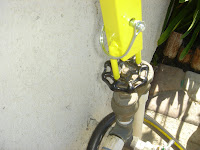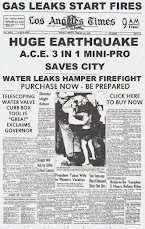Trics of the Trade: New Hazmat Threat Comes to the US Hydrogen Sulfide is a new method of suicide
TONY TRICARICO
Firehouse.Com Contributor A popular means of suicide, is there such a thing? Well apparently there is now.
In the first six months of 2008, the press reports that in Japan more than 500 people have killed themselves using hydrogen sulfide created by mixing chemicals commonly available over the counter in supermarkets and drug stores. Japan's government has long battled to contain the country's alarmingly high suicide rate. A total of 32,155 people killed themselves in 2006, giving the country the ninth highest rate in the world.
Suicides first passed the 30,000 mark in 1998, near the height of an economic slump that left many bankrupt, jobless and desperate. The Japanese government has earmarked 22.5 billion yen ($220 million) for anti-suicide programs to help those with depression and other mental conditions. Last year it set a goal of cutting the suicide rate by 20 percent in 10 years through steps such as reducing unemployment, boosting workplace counseling and filtering Web sites that promote this despicable act.
According to official statistics, about a million people die by suicide annually, more than those murdered or killed in war. According to 2005 data, suicides in the U.S. outnumber homicides by nearly two-to-one and ranks as the 11th leading cause of death in the country, ahead of liver disease and Parkinson's disease. According to a 2008 report from the Johns Hopkins Bloomberg School of Public Health's Center for Injury Research and Policy, the rate of suicide in the United States is increasing for the first time in a decade. The increase in the overall suicide rate between 1999 and 2005 was due primarily to an increase in suicides among whites aged 40-64, with white middle-aged women experiencing the largest annual increase.
Worldwide suicide rates have increased by 60 percent in the past 50 years, mainly in the developing countries. Most suicides in the world occur in Asia, which is estimated to account for up to 60 percent of all suicides. According to the World Health Organization, China, India and Japan may account for 40 percent of all world suicides.
Many of these incidents have occurred in apartments, private houses and vehicles. Authorities, (you and I), are concerned that it could become "more popular" in the United States as the publicity about these incident spreads.
In fact, in August 2008 the Pasadena, CA, Fire Department responded to a suicide involving Hydrogen Sulfide. The victim, found dead in his car, had mixed a fungicide and a toilet bowl cleaner in a plastic tray creating a bright blue liquid and placed the tray in the back seat of his vehicle. The man that killed himself placed a note on the vehicle warning first responders of the hazard. A subsequent investigation revealed that this person may have been to multiple web sites of Japanese origin that provides information on how to use Hydrogen Sulfide as a tool to commit suicide.
Although this incident is a suicide, it demonstrates the potential for anyone to easily produce the chemical and use it as a weapon in a terrorist attack. The Pasadena incident led to the evacuation of several businesses in the immediate area and left bystanders stranded for as much as five hours while the first responders assessed the scene.
In another incident in Japan, 90 people in an apartment building were reportedly sickened when a teenage girl killed herself using a mixture of household chemicals that produced the Hydrogen Sulfide in the bathroom of her apartment.
Hydrogen Sulfide is also known by the following names; hydro sulfuric acid; sulfuretted hydrogen; sewer gas; sulfane; sulfur hydride; sour gas; sulfurated hydrogen; hydrosulfuric acid; stink damp; and rotten egg gas. Its chemical molecular formula is H2S. H2S is a colorless, toxic, flammable gas with a strong odor of rotten eggs or flatulence. Odor is not a reliable indicator as to the concentrations because the sense of smell becomes rapidly fatigued and can not be relied upon to warn of the continuous presence of the gas. H2S is a by product of the decay of organic material and accidental exposure has occurred in situations involving sewage, liquid manure, natural gas, and animal and vegetable matter storage and processing. It can also be found at certain industrial facilities, such as waste water treatment plants, petroleum refineries, pulp and paper manufacturers, and plants producing sulfur or sulfuric acid. Small amounts of hydrogen sulfide occur in crude petroleum but natural gas can contain up to 80 percent. It is shipped as a liquefied compressed gas, bearing the placard 2.3, and the UN 1053.
The gas can be detected at a level of two parts per billion. To put this into perspective, 1 mL of the gas distributed evenly in a 100-seat lecture hall is about 20 ppb. The IDLH for this gas is 100 ppm. Remember that in determining IDLHs, NIOSH figures the ability of a worker to escape without loss of life or irreversible health effects being considered along with severe eye or respiratory irritation and other deleterious effects (for example: disorientation or loss of coordination) that could prevent escape. Although in most cases, egress from a particular worksite could occur in much less than 30 minutes, as a safety margin, IDLHs were based on the effects that might occur as a consequence of a 30-minute exposure. However, the 30-minute period was NOT meant to imply that workers should stay in the work environment any longer than necessary following the failure of respiratory protection equipment; in fact, every effort should be made to exit immediately.
The Occupational Safety and Health Administration (OSHA) defines an immediately dangerous to life or health concentration in their hazardous waste operations and emergency response regulation as follows: An atmospheric concentration of any toxic, corrosive or asphyxiant substance that poses an immediate threat to life or would cause irreversible or delayed adverse health effects or would interfere with an individual's ability to escape from a dangerous atmosphere. [29 CFR 1910.120]
Hydrogen sulfide is a highly toxic and flammable gas. Being heavier than air, it tends to accumulate at the bottom of poorly ventilated spaces. Although very pungent at first, it quickly deadens the sense of smell, so potential victims may be unaware of its presence until it is too late.
Hydrogen sulfide is considered a broad-spectrum poison, meaning that it can poison several different systems in the body, although the nervous system is most affected. The toxicity of H2S is comparable with that of hydrogen cyanide. It forms a complex bond with iron in the mitochondrial cytochrome enzymes, thereby blocking oxygen from binding and stopping cellular respiration. It's kind of the opposite of Carbon Monoxide, when CO is inhaled; it combines with the oxygen forming carboxyhemoglobin. Since hydrogen sulfide occurs naturally in the environment and the stomach, enzymes exist in the body capable of detoxifying it by oxidation in to (harmless) sulfate.
Exposure to lower concentrations can result in eye irritation, a sore throat and cough, nausea, shortness of breath, and fluid in the lungs. These symptoms usually go away in a few weeks. Long-term, low-level exposure may result in fatigue, loss of appetite, headaches, irritability, poor memory, and dizziness. Concentrations of 700-800 ppm tend to be fatal.
Toxicity levels are:
- 0.0047 ppm is the recognition threshold, the concentration at which 50 percent of humans can detect the characteristic odor of hydrogen sulfide, normally described as resembling "a rotten egg"
- 10-20 ppm is the borderline concentration for eye irritation
- 50-100 ppm leads to eye damage
- At 150-250 ppm the olfactory nerve is paralyzed after a few inhalations, and the sense of smell disappears, often together with awareness of danger
- 320-530 ppm leads to pulmonary edema with the possibility of death
- 530-1000 ppm causes strong stimulation of the central nervous system and rapid breathing, leading to loss of breathing
- 800 ppm is the lethal concentration for 50percent of humans for five minutes exposure
- Concentrations over 1000 ppm cause immediate collapse with loss of breathing, even after inhalation of a single breath.
Hydrogen sulfide has been used for well over a century as a method of qualitative analysis of metal ions. In fact, the Chemistry Building at the University of Illinois in 1915 had a built-in supply of hydrogen sulfide to the various labs, i.e., H2S "on tap"! The gas was stored in a 500-gallon tank! The density of hydrogen sulfide is 1.393 g/L at 25 oC and 1 atm. This is 18 percent greater than that of air.
Hydrogen sulfide dissolves in water to make a solution that is weakly acidic. So what do we do? Know your enemy. When responding to incidents, especially suicides, be aware of the possibility of hydrogen sulfide gas. You leave the rig and someone comes up to you stating that they feel dizzy or perhaps nausea, and they have a slight smell of rotten eggs, what do you suspect. As you get on the rig, you read the dispatch ticket and it states "unusual odor throughout bldg. Multiple persons sick", you got your first clue.
Remember we may need to evacuate, this is a highly flammable gas with properties that make it heavier than air. The vapors may travel along the ground finding a source of ignition and flash back. The gas may collect in a basement, sewage system or a ravine. And most importantly, our fire fighting gear offers only limited protection, it is not effective in a spill situation or where direct contact with the chemical will be made.
An interesting diagnostic clue of extreme poisoning by H2S is the discoloration of copper coins in the pockets of the victim.
Speak to the members at roll call and company drills. Discuss the properties of this gas and make everyone aware of the necessary changes in tactics to increase our survivability. Expect the unexpected. Stay focused. Transmit the proper codes to get the hazmat team on scene and have the proper meters available.
Have everyone in SCBA, and if it's a large operation, like, perhaps an apartment building, transmit additional alarms or call for mutual aide early, and don't forget the apparatus that supplies or refills the SCBA.
Should you have an encounter with a suspicious incident involving Hydrogen Sulfide notify the Department of Homeland Security and the FBI. You can find them on their websites.
In closing I would like to leave you with a thougth to ponder, a buildup of hydrogen sulfide in the atmosphere may have caused the massive extinction event on our planet 252 million years ago. This is just one more...Tric of the Trade.
Source: Firehouse.com article -
Link









